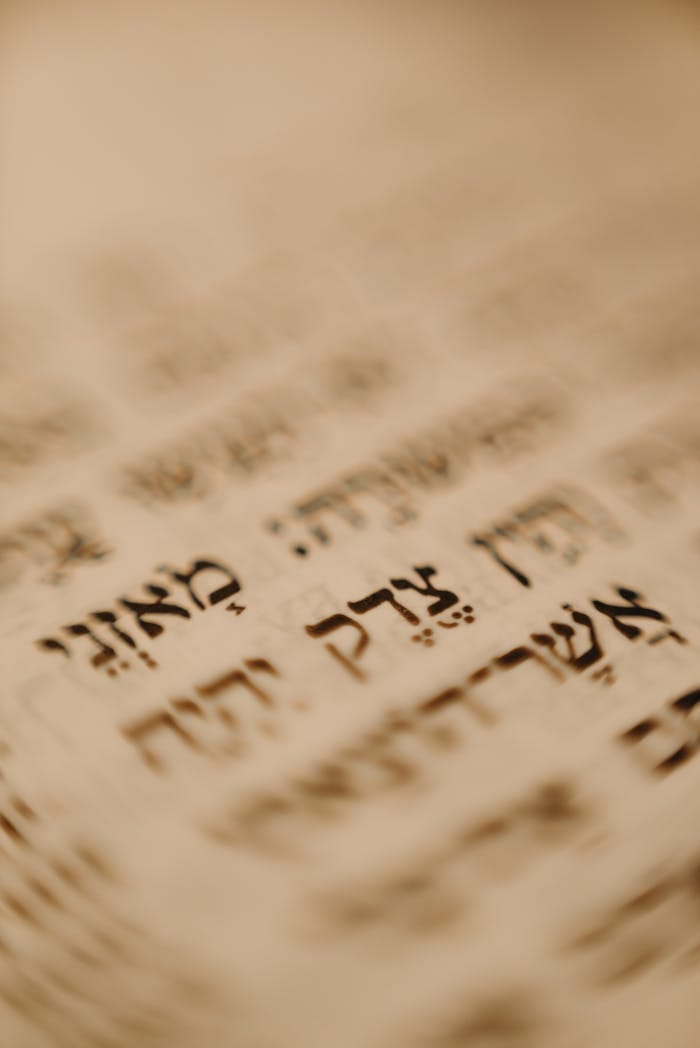Biblical Hebrew: Your Ultimate Guide to Deeper Insight
Have you ever read a familiar Bible verse and wondered if you were missing something? Is there a deeper layer of meaning, a richer understanding, that gets lost in translation? For many of us, the answer is a resounding yes. Biblical Hebrew is the ancient language of the Old Testament, the very words God used to communicate with His people. It connects us directly to the foundational truths of our faith and the culture of the Israelites that God chose.
Studying this language is more than just an academic exercise; it’s a journey into the heart of scripture. It opens up a world of nuance, poetry, and profound theological meaning that is often difficult to convey in translation. In short, it helps us appreciate the depth of God’s Word. As Proverbs 15:2 reminds us, “The tongue of the wise commends knowledge,” and by diligently seeking to know the original language of the Bible, we can commend knowledge in a more complete and beautiful way. In this comprehensive guide, we’ll explore the basics of biblical Hebrew, the incredible rewards of studying it, its unique features, and practical steps to start your own rewarding journey.
What Is Biblical Hebrew and Why Does It Matter?
Biblical Hebrew, also known as Classical Hebrew, is a West Semitic language that was used to write the majority of the Hebrew Bible (the Old Testament). It is the language of Moses, David, and the prophets. While some portions of the Old Testament (like sections of Ezra and Daniel) were written in Aramaic—a related Semitic language—Hebrew remains the primary linguistic DNA of the Old Testament. The language flourished in ancient Israel, but its use as an everyday spoken language declined after the Babylonian exile in the 6th century B.C.E. However, biblical Hebrew was never lost. It continued to be used for religious, literary, and scholarly purposes, which is a testament to its enduring significance.
The evolution of biblical Hebrew across different books of the Hebrew scripture reflects the history of its people. The poetry of the Psalms, for instance, has a different feel from the prose in the book of Genesis. The language used in the book of Isaiah, a prophet who lived during a time of immense political and spiritual turmoil, is different from the language of Ecclesiastes, which reflects a more philosophical, post-exilic perspective. This evolution doesn’t diminish the divine authority of the text; rather, it highlights the living, dynamic relationship God had with a people throughout their history.
Why should a modern-day Christian or anyone interested in Bible scholarship care about a language that hasn’t been spoken colloquially for over 2,500 years? The answer lies in the invaluable insight it provides. Every translation is an interpretation, a human effort to capture divine meaning in a different tongue. By learning the original biblical Hebrew language, you can directly engage with the text. This allows you to uncover layers of meaning, see deliberate word choices, and appreciate literary devices that might be invisible in translation.
For example, when Genesis 1:1 says, “In the beginning, God created the heavens and the earth,” the verb “created” is the Hebrew word bara. This word is exclusively used for divine creation, showing that only God can bring something into existence out of nothing. It’s a powerful theological concept embedded right in the verb itself. Similarly, the first word of the Bible, Bereishit, is not just a simple title, but a rich phrase meaning “in the beginning of,” hinting at a creative process that is just starting. This kind of nuance is a gift to those who choose to dig deeper.
Exploring the Unique Features of the Hebrew Alphabet and Language
The fundamental building blocks of biblical Hebrew are what make it so unique. It’s a language built on an elegant and concise system of roots, patterns, and consonants that convey deep meaning. This ancient linguistic framework is a key to unlocking the text’s original power and theological depth. Every letter and word choice was deliberate, forming a system that is both poetic and precise. To begin our journey of understanding, we must first familiarize ourselves with the foundation: the Hebrew alphabet itself.

The Hebrew Alphabet: The Aleph Bet
The foundation of the language is the Hebrew alphabet, a system of 22 letters known as the Aleph Bet. Unlike the English alphabet, all 22 of these letters are consonants. This means that to convey vowel sounds, a system of small dots and dashes called niqqud are added to the consonants. For a new learner, this can feel like a foreign concept, but it’s a manageable system once you get the hang of it.
For example:
- א (Aleph): Is silent, but can take different vowel sounds, such as:
- אָ (kamatz) makes the “ah” sound.
- אִ (hiriq) makes the “ee” sound.
- ב (Bet): Sounds like “b” or “v” depending on its usage, with or without the dagesh (dot in the middle):
- בּ: “b” as in “boy” (with a dagesh).
- ב: “v” as in “victory” (without a dagesh).
- ג (Gimel): Can be combined with nikkud, such as:
- גִּ (with hiriq): “gi” as in “give.”
- גָּ (with kamatz): “gah” as in “garden.”
Beyond their phonetic use, the Hebrew letters also hold rich symbolic meaning. Each letter has a name, a sound, a numerical value, and an ancient pictograph. The letter Aleph (א), for example, represents an ox and symbolizes strength and leadership. The letter Bet (ב), which looks like a house, symbolizes a home or dwelling.
While not a primary way to interpret scripture, understanding the visual and symbolic nature of the letters can add a beautiful layer of appreciation to the text for the seasoned believer. For example, the very first word of the Bible, Bereishit, begins with the letter Bet, a hint that creation is a divine “house” or home being built for humanity. it provides context for ancient rituals, prayers, and beliefs. This can enrich your study of both faiths.

The Power of Roots and Patterns
The brilliance of the biblical Hebrew language lies in its three-letter root system. Most words are built from a simple, three-consonant root that carries a core meaning. This is perfect for recognizing and deciphering new words, even if you’ve never seen them before. The root K-T-V (כתב), for example, always relates to the concept of “writing.” From this root, you can form:
- Katav (כתב): “He wrote”
- Ketuvim (כתובים): “Writings” (a section of the Hebrew Bible)
- Mikhtav (מכתב): “A letter”
- Koteb (כותב): “He is writing”
This system makes learning vocabulary an intuitive process. Once you know a root, you have a solid foundation for understanding many related words. This is a fundamental concept in biblical Hebrew that makes the language highly logical and systematic.
A Verb-Centric Language
In Hebrew scripture, verbs are the star of the show. They carry the core meaning of a sentence and are structured to convey not only tense but also gender and number. They are formed through specific patterns, known as Binyanim (or “constructions”). While this might sound intimidating, these patterns are predictable and provide a wealth of information.
The simplest verb pattern is the Qal stem, which usually represents the basic or simple action (e.g., shamar, “to guard”). Other stems modify this meaning: the Nifal stem often makes the verb passive (“to be guarded”), while the Piel stem intensifies the action (“to guard diligently” or “to keep”). For seasoned believers, recognizing these verb patterns is like gaining a new set of eyes for the Bible. You begin to see the specific intent of the author, understanding why they chose to say “he was healed” (passive) versus “he healed” (active).
Navigating the Path to Learning Biblical Hebrew
Learning a new language is a commitment, but the resources available today make it more accessible than ever before. For anyone feeling called to this journey, here is a practical roadmap.
- Start with the Alphabet: Do not rush this step. Master the 22 consonants and the vowel marks. Practice writing them by hand to build muscle memory and recognize them at a glance. There are many great online guides and apps that have audio pronunciations to help you get the sounds right. Mastering the Hebrew letters is the first, most rewarding step.
- Use Flashcards and Apps: Building vocabulary is a long-term effort. Apps like Memrise or Anki can help you memorize the most common biblical words. You might also consider using physical note cards to get away from a screen for a bit. The important thing is to find a method that works for you.
- Start with Familiar Passages: Don’t try to translate Leviticus on your first day. Begin with well-known texts like Psalm 23 or Genesis 1:1. Use an interlinear Bible, which places the Hebrew word directly above its English translation. This will help you see the word order, grammar, and sentence structure in a non-intimidating way.
- Join a Study Group: Learning with others provides accountability and community. You can share challenges, celebrate small victories, and learn from each other. In a group, you can also practice reading the text out loud, which is essential for proper pronunciation.
- Practice Daily: Consistency is more important than duration. Commit to a short, daily study session, even if it’s just for 15-20 minutes. Small, regular efforts over time will build momentum and produce big results. The more you immerse yourself in the language, the more it will become a natural part of your study routine. You may benefit from using Introduction to Hebrew: A Guide for Learning and Using Biblical Hebrew, by William Fullilove. His book is comprehensive and offers many exercises to help you translate and improve your understanding of the Hebrew language.
For biblical Hebrew learners, the feeling of reading a biblical text in its original language for the first time is a profound experience. Imagine reading Psalm 23 in Hebrew and seeing how the language beautifully paints a picture of God as a shepherd. It’s an intimate moment of connection with a 3,000-year-old text, made possible by your diligence.
Biblical Hebrew vs. Modern Hebrew
While related, biblical Hebrew and Modern Hebrew are distinct. Think of it like comparing Shakespearean English to modern-day English. You can recognize a lot of the same words and grammar, but the vocabulary, pronunciation, and flow are different. Modern Hebrew, a language revived in the 19th and 20th centuries, includes thousands of new words for technology and modern concepts. Its pronunciation is also different, and it has simplified some of the complex grammatical features found in biblical Hebrew.
For example, a modern Israeli would not speak in the same way the prophet Isaiah wrote. However, knowing biblical Hebrew is a tremendous advantage for those who wish to learn Modern Hebrew. The reverse is also true. The two are intertwined, sharing the same Hebrew alphabet and foundational grammar.

Why the Hebrew Bible Is Foundational to Christian Faith
The Hebrew Bible, which Christians call the Old Testament, is not simply a historical document; it is the divinely inspired foundation of our faith. For new believers, understanding its connection to the New Testament can deepen their appreciation for God’s overarching plan. For seasoned scholars, it provides a wellspring of theological insight.
- Fulfillment of Prophecy: The New Testament is filled with direct quotes and allusions to the Hebrew Bible. The prophets foretold the coming of the Messiah, His life, death, and resurrection. By studying the Hebrew scripture, we can see how Jesus perfectly fulfilled these ancient prophecies. He is the ultimate reality to which the Old Testament pointed. (Link to Messianic Prophecies article)
- Jesus’s Scriptures: Jesus himself read, studied, and taught from the Hebrew Bible. The disciples were also deeply rooted in this tradition. To understand Jesus and his teachings, one must understand the biblical Hebrew scriptures He studied.
- Theological Vocabulary: The theological concepts that shape our understanding of grace, salvation, and God’s character are all introduced and explored in the Hebrew Bible. Words like hesed (steadfast, loyal love) and shalom (a holistic sense of peace, wholeness, and well-being) originated here and carry their full weight in their original context.
Learning biblical Hebrew allows you to engage with the very scriptures that shaped Jesus’s mind and heart. This level of connection is unparalleled and a gift to any serious student of the Bible.
The Immeasurable Reward of Knowing the Original Language
The journey of learning biblical Hebrew is not without its challenges. The grammar can be complex, especially the verb conjugations, and the right-to-left script may feel unnatural at first. It takes time and effort. But the rewards are immeasurable.
Imagine the feeling of reading Psalm 23 and understanding its profound meaning on a deeper level. The phrase “The Lord is my shepherd” in Hebrew is YHWH ro’i, a simple yet powerful declaration that God is not just a shepherd in a metaphorical sense, but the one who intimately cares for His flock. Or think about the word for peace, shalom. It is far more than a lack of conflict. It refers to a deep sense of wholeness, completeness, and flourishing. When you use this term in your own prayers, it carries the weight of a far richer biblical understanding.
In the end, learning biblical Hebrew is a testament to the idea that God’s Word is worth the effort. It is a form of worship, a spiritual discipline that transforms the way you read and live out your faith. It moves your study from a passive activity to an active, engaging encounter with the very words of God. As you begin your journey, you will find that the language, once foreign, becomes a beautiful, ancient friend.
Conclusion
The Book of Psalms, in its original Hebrew, is a raw and honest collection of praises and prayers that have resonated with believers for millennia. Likewise, the entire Hebrew Bible holds a depth of meaning that is waiting to be uncovered. Learning biblical Hebrew is the key to unlocking these treasures.
This journey is a rewarding one, whether you are a new believer seeking a deeper understanding of the foundations of your faith or a seasoned scholar looking for new insights. By understanding the Hebrew alphabet, the root system, and the powerful nuances of the language, you can gain a profound appreciation for God’s Word.
Key Takeaways for Your Journey:
- Biblical Hebrew is a powerful Semitic language that offers profound insights often lost in translation.
- The three-letter root system and the Hebrew alphabet are the fundamental keys to understanding the language.
- Studying it deepens your spiritual connection and enhances your appreciation for the Hebrew scripture as the foundation of Christian faith.
- Start by mastering the basics, use available resources, and stay consistent.
You may benefit from using Introduction to Hebrew: A Guide for Learning and Using Biblical Hebrew, by William Fullilove. His book is comprehensive and offers many exercises to help you translate and improve your understanding of biblical Hebrew.
Start your journey today. Engage with the original words of the Bible and experience a new level of intimacy with the text. This will transform your Bible scholarship in a truly meaningful way, much like a person’s ability to communicate with another is deepened when they can speak the same language.

